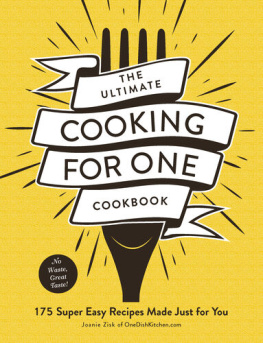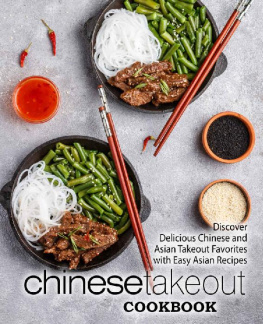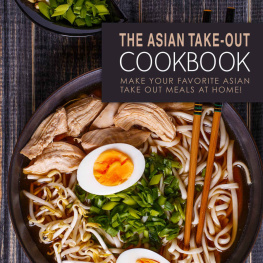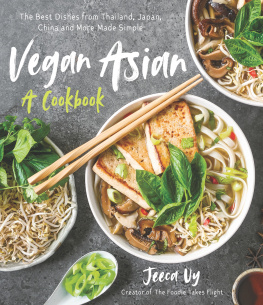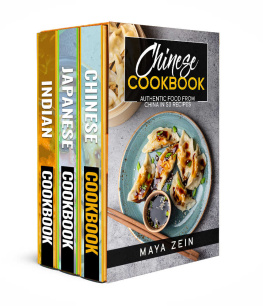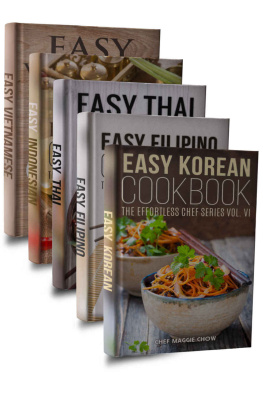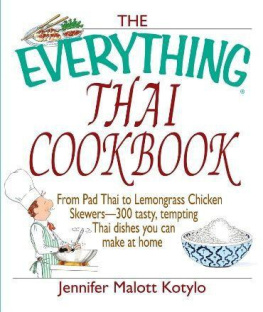Contents
Guide
Letter to the Reader
Dear Reader,
Growing up, the only Asian food I ever had was the occasional order of takeout Chinese. When I met my husband, who is half Chinese, I was introduced to a new world of fresh ingredients and bold flavors! His mother taught me the art of Chinese cooking, kindly sharing her recipes and techniques with me, and I fell in love with Chinese cooking at home.
This spurred me to learn about other Asian cuisines, where I discovered the bright tang of lemongrass, creamy coconut milk curries, and steaming bowls of ramen and ph. My personal travels include two trips to Japan, where I spent my days exploring the streets of Tokyo, eating everything I could get my hands on, from sushi at dawn in a bustling fish market to cooking my own humble meals in a tiny Japanese kitchen.
I hope in this book you find tips, recipes, and information that will make your own Asian cooking adventures easy and tasty! This book explores the cuisines of Asia from China to Vietnam, with recipes easy enough for weeknight meals, yet sophisticated enough to impress guests. With these recipes I hope you, too, will develop a passion for the flavors and cuisines of Asia!
Kelly Jaggers
Welcome to the Everything Series!
These handy, accessible books give you all you need to tackle a difficult project, gain a new hobby, comprehend a fascinating topic, prepare for an exam, or even brush up on something you learned back in school but have since forgotten.
You can choose to read an Everything book from cover to cover or just pick out the information you want from our four useful boxes: e-questions, e-facts, e-alerts, and e-ssentials. We give you everything you need to know on the subject, but throw in a lot of fun stuff along the way, too.
We now have more than 400 Everything books in print, spanning such wide-ranging categories as weddings, pregnancy, cooking, music instruction, foreign language, crafts, pets, New Age, and so much more. When youre done reading them all, you can finally say you know Everything!

Answers to common questions

Important snippets of information

Urgent warnings

Quick handy tips
Visit the entire Everything series at www.everything.com
The Everything Easy Asian Cookbook
Kelly Jaggers

Avon, Massachusetts
Dedication
To Lee, who taught me to love Asian food.
Copyright 2015 by F+W Media, Inc.
All rights reserved.
This book, or parts thereof, may not be reproduced in any form without permission from the publisher; exceptions are made for brief excerpts used in published reviews.
An Everything Series Book.
Everything and everything.com are registered trademarks of F+W Media, Inc.
Published by
Adams Media, a division of F+W Media, Inc.
57 Littlefield Street, Avon, MA 02322. U.S.A.
www.adamsmedia.com
Contains material adapted from The EverythingChinese Cookbook by Rhonda Lauret Parkinson, copyright 2003 by F+W Media, Inc., ISBN 10: 1-58062-954-7, ISBN 13: 978-1-58062-954-6; The EverythingChinese Cookbook, 2nd Edition by Manyee Elaine Mar, copyright 2013 by F+W Media, Inc., ISBN 10: 1-4405-6819-7, ISBN 13: 978-1-4405-6819-0; The EverythingThai Cookbook by Jennifer Malott Kotylo, copyright 2002 by F+W Media, Inc., ISBN 10: 1-58062-733-1, ISBN 13: 978-1-58062-733-7; The EverythingThai Cookbook, 2nd Edition by Jam Sanitchat, copyright 2013 by F+W Media, Inc., ISBN 10: 1-4405-6154-0, ISBN 13: 978-1-4405-6154-2; The EverythingStir-Fry Cookbook by Rhonda Lauret Parkinson, copyright 2007 by F+W Media, Inc., ISBN 10: 1-59869-242-9, ISBN 13: 978-1-59869-242-6; and The EverythingStir-Fry Cookbook, 2nd Edition by Nam Nguyen, copyright 2013 by F+W Media, Inc., ISBN 10: 1-4405-6157-5, ISBN 13: 978-1-4405-6157-3
ISBN 10: 1-4405-9016-8
ISBN 13: 978-1-4405-9016-0
eISBN 10: 1-4405-9017-6
eISBN 13: 978-1-4405-9017-7
Library of Congress Cataloging-in-Publication Data
Jaggers, Kelly.
The everything easy Asian cookbook / Kelly Jaggers.
pages cm
Includes index.
ISBN 978-1-4405-9016-0 (pb) -- ISBN 1-4405-9016-8 (pb) -- ISBN 978-1-4405-9017-7 (ebook) -- ISBN 1-4405-9017-6 (ebook)
1. Cooking, Asian. I. Title.
TX724.5.A1J34 2015
641.595--dc23
2015009424
Always follow safety and commonsense cooking protocol while using kitchen utensils, operating ovens and stoves, and handling uncooked food. If children are assisting in the preparation of any recipe, they should always be supervised by an adult.
Many of the designations used by manufacturers and sellers to distinguish their products are claimed as trademarks. Where those designations appear in this book and F+W Media, Inc. was aware of a trademark claim, the designations have been printed with initial capital letters.
Cover and interior photos by Kelly Jaggers.
Acknowledgments
I would like to first thank Lisa, Eileen, and Erin at Adams Media. I appreciate everything you do. This would not be possible without you. I would also like to thank Lee for teaching me about Asian cooking, and for showing me there is more to Asian food than what I had known. As always, I want to thank my familyCarol, Howard, Wayne, and Nonniefor their constant support and encouragement. A special thank you to my physical therapist, Britney, for helping me be better, and to Jodi, who is not only kind and encouraging, but also the reason I have time to do what I love. Last, but not least, I want to thank my husband, Mark, for his willingness to be my taste tester, for taking me to Japan, and for his honesty. Just because you love me does not mean you pull any punches.
Introduction
The best ambassador of Asian culture is its food. The cuisines of Asia reflect the history, experiences, and diversity of the continent and the people who live there. From bold spicy dishes to delicate soups, Asian cuisine is as varied as the people and landscapes from where it originates. While many of the ingredients used across Asia are common, they are used in uncommon ways, making each cuisine unique. Places such as China, Korea, and Japan emphasize the balanced use of fats, oils, and sauces in cooking. In Southeast Asia, steaming, boiling, and lighter flavored, less fatty dishes are most popular. Foods and spices are used to promote health, not unlike medicine, and food is often used as symbolic offerings in various religions.
In China, there are eight recognized and distinct cooking styles based on region: Cantonese, Szechwan, Shandong, Fujian, Jiangsu, Hunan, Anhui, and Zhejiang. This diversity means there is great variety in Chinese ingredients, cooking styles, and recipes. In general, rice, noodles, and vegetables are staple ingredients in Southern Chinese dishes, which emphasize fresh ingredients cooked with lighter sauces. In Northern Chinese cuisine, many dishes rely more on the use of oil, vinegar, spices, and garlic.


